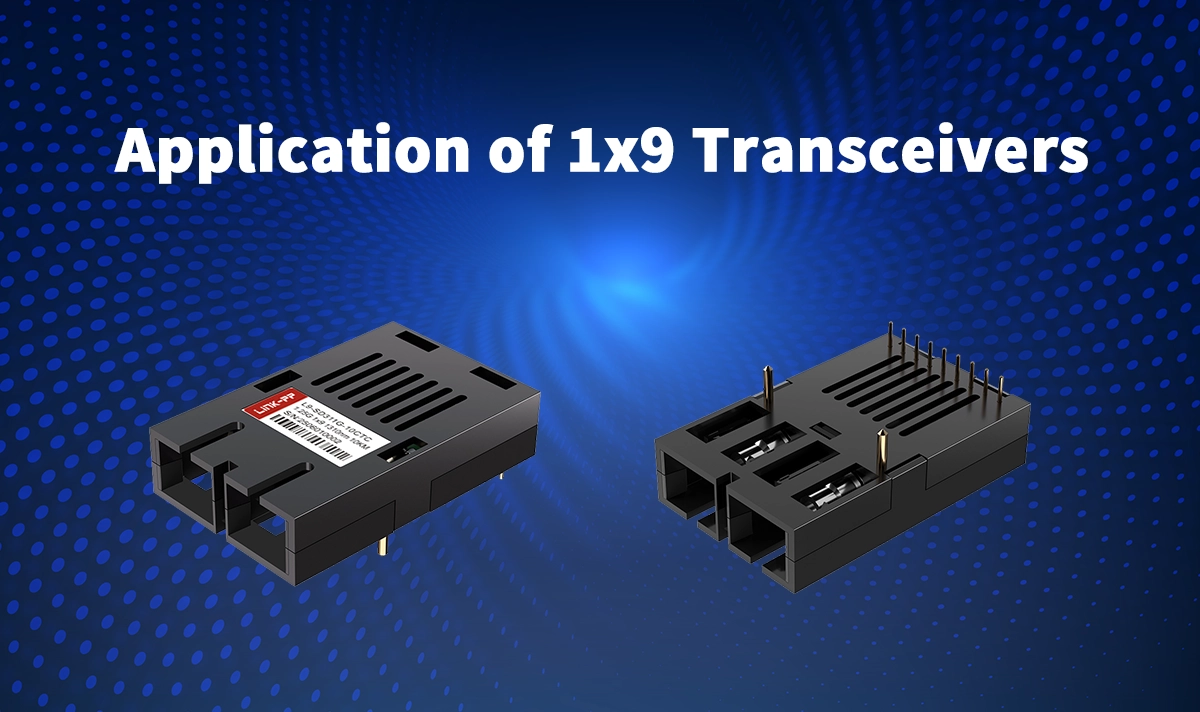
In the relentless pursuit of higher speeds and denser packaging, optical transceiver technology constantly evolves. Yet, amidst the rise of compact Small Form-Factor Pluggables (SFP, SFP+, QSFP+) and cutting-edge Coherent modules, the humble 1x9 optical transceiver remains a critical, reliable workhorse in numerous applications. Often overlooked in discussions dominated by the latest innovations, this robust form factor continues to deliver essential connectivity where simplicity, durability, and cost-effectiveness are paramount. Understanding where and why 1x9 modules persist offers valuable insight into the diverse landscape of optical networking.
☑ What Exactly is a 1x9 Optical Transceiver?

The name "1x9" refers to pin configuration: 1 row of 9 electrical pins for connecting to networking equipment. Unlike their pluggable successors, 1x9 transceivers are typically fixed devices. They are soldered directly onto the host printed circuit board (PCB) within networking equipment. This inherent design brings distinct advantages and limitations:
Key Advantages:
Robustness & Reliability: The fixed connection eliminates connector wear and tear, vibration issues, and potential points of failure associated with pluggable interfaces. This makes them exceptionally reliable.
Cost-Effectiveness: Simpler design and direct PCB mounting often result in a lower cost per unit compared to equivalent pluggable modules.
Space Efficiency (in Design): For equipment manufacturers, integrating fixed 1x9 optical modules can sometimes allow for more compact overall device designs, as they don't require cages, latching mechanisms, or front-panel access.
Power Efficiency: Generally, they consume slightly less power than pluggable equivalents due to the lack of complex control circuitry for hot-plugging.
Deterministic Performance: Fixed configuration simplifies design and testing for OEMs.
Key Limitations:
Non-Pluggable: Cannot be easily replaced or upgraded without soldering, requiring technician intervention and potentially taking the entire system offline.
Limited Configuration Flexibility: Port types and speeds are fixed at the time of equipment manufacturing.
Lower Speeds: Primarily used for legacy and industrial speeds like Fast Ethernet (100Mbps), Gigabit Ethernet (1Gbps), 1G/2G Fibre Channel, and lower-rate SONET/SDH (OC-3/STM-1, OC-12/STM-4, OC-48/STM-16).
☑ Where 1x9 Optical Transceivers Shine: Core Applications
Despite the dominance of pluggables in data centers and enterprise core networks, 1x9 transceiver applications remain vital in specific sectors:
Industrial Networking & Automation:
Harsh Environments: Manufacturing plants, power utilities, oil & gas facilities, and transportation systems demand extreme reliability. The ruggedness of fixed 1x9 optical modules makes them ideal for resisting temperature extremes, dust, moisture, and vibration. Think industrial SFP alternative.
Machine-to-Machine (M2M) Communication: Connecting PLCs, sensors, HMIs, and control systems often requires robust, simple Gigabit or Fast Ethernet links over fiber. 1x9 SFP equivalent modules provide this reliably.
Protocol Support: Widely used with industrial protocols like PROFINET, EtherNet/IP, and Modbus TCP/IP running over fiber for electrical noise immunity and longer distances.
Telecommunications Access & Legacy Infrastructure:
Customer Premises Equipment (CPE): Older Optical Network Terminals (ONTs), Digital Subscriber Line Access Multiplexers (DSLAMs), and Multiplexers (MUXs) frequently utilize fixed 1x9 optical modules for uplink connections (e.g., Gigabit Ethernet or lower-speed SONET/SDH) due to their proven reliability and cost structure.
Legacy SONET/SDH Equipment: Much existing metro and access layer telecom infrastructure, especially in remote areas or for specific services, still relies on OC-3/12/48 rates delivered via 1x9 optical transceivers. Maintaining this infrastructure requires compatible modules.
Low-Cost Fiber Aggregation: For aggregating lower-speed links in access networks or remote cabinets, 1x9 solutions remain a cost-effective choice.
Embedded Systems & Specialized Equipment:
Medical Devices: Imaging systems, diagnostic equipment, and hospital network infrastructure sometimes leverage the reliability of fixed fiber optic modules.
Military & Aerospace: Ruggedized communication systems benefit from the durability and fixed nature of 1x9 form factor optics.
Test & Measurement Equipment: Certain specialized instruments incorporate fixed optics for internal communication or specific interface requirements.
Broadcast & Professional AV: Where robust, jitter-free signal transmission over fiber is needed in fixed installations.
Cost-Sensitive Network Deployments:
Emerging Markets & SMBs: For basic fiber connectivity needs (e.g., connecting two buildings with Gigabit Ethernet) where the absolute lowest cost and maximum reliability are key, equipment using fixed 1x9 optical modules can be an attractive solution.
☑ Comparing 1x9 to Pluggable Form Factors
Understanding the positioning of 1x9 optical transceivers requires comparison:
Feature | 1x9 Optical Transceiver | SFP/SFP+ Module | Key Differentiator |
|---|---|---|---|
Form Factor | Fixed (Soldered) | Pluggable (Hot-swappable) | Serviceability & Upgradability |
Installation | Soldered to PCB (OEM Level) | User-Installable | Ease of Replacement |
Primary Speeds | FE, 1GbE, 1G/2G FC, OC-3/12/48 | 1GbE, 10GbE, 16G FC, Higher | Speed Capability |
Cost (Module) | Generally Lower | Generally Higher | Bill of Materials |
Robustness | High (Fixed Connection) | Medium (Depends on Connector) | Reliability in Harsh Environments |
Flexibility | Low (Fixed at Build) | High (Field Configurable) | Network Adaptability |
Power Consumption | Generally Lower | Generally Higher | Energy Efficiency |
Typical Use Case | Industrial, Legacy Telecom, Embedded Systems | Data Centers, Enterprise Networks, Modern Telecom | Application Suitability |
☑ LINK-PP: Your Trusted Partner for 1x9 Optical Solutions

As a leader in optical transceiver solutions, LINK-PP understands the critical role reliable legacy components play. We offer a comprehensive range of high-quality, MSA-compliant 1x9 optical transceivers designed for maximum performance and longevity in demanding applications. Whether you're an OEM integrating optics into industrial switches or a service provider maintaining legacy telecom infrastructure, LINK-PP provides the dependable connectivity you need.
Common LINK-PP 1x9 Optical Transceiver Models Include:
LINK-PP L9-SD311G-10CTC: 1000BASE-LX, Single mode, 1310nm, 10km, Dual SC, CML Differential Input/Output and TTL signal detect
LINK-PP L9-SD311G-20PPC: 1000BASE-LX, 1310nm, Single-mode, 20km, Dual SC, PECL Differential Input/Output and PECL signal detect
LINK-PP L9-SD311G-20PTC: 1000BASE-LX, 1310nm, Single-mode, 20km, Dual SC, PECL Differential Input/Output and TTL signal detect
☑ Ensuring Compatibility and Performance
When sourcing 1x9 optical transceivers, especially from third-party manufacturers like LINK-PP, compatibility is crucial. Reputable suppliers ensure:
MSA Compliance: Adherence to Multi-Source Agreement mechanical and electrical specifications.
Rigorous Testing: Full testing against industry standards (IEEE, Telcordia, etc.) and often vendor-specific parameters.
Quality Components: Use of high-grade lasers, detectors, and PCBs for reliability.
Long-Term Availability: Commitment to supporting legacy technologies.
☑ Troubleshooting Tips for 1x9 Modules
Since they are fixed, issues often point to the module itself or the host board:
No Link Light: Check fiber continuity (clean connectors!), verify wavelength and fiber type match (MM/SM), confirm correct speed/duplex settings on the host port. Rule out host board failure.
Intermittent Link/Errors: Suspect dirty fiber connectors, marginal optical power levels (check specs), potential damage to the fiber cable, or host board issues. Vibration can sometimes affect solder joints (rare).
Complete Failure: Often indicates a failed 1x9 optical transceiver or a failure on the host board. Requires technical diagnosis and potentially board-level repair/replacement.
☑ Conclusion: The Unseen Backbone
While not grabbing headlines like 800G coherent modules, the 1x9 optical transceiver remains a foundational technology. Its unique blend of robustness, reliability, and cost-effectiveness ensures its continued relevance in industrial automation, legacy telecommunications, embedded systems, and cost-sensitive deployments. For applications demanding unwavering performance in challenging environments without the need for field upgrades, the 1x9 form factor is often the optimal optical transceiver solution.
See Also
What You Need to Know About 1x9 Optical Transceivers
Join The Vibrant And Growing LINK-PP Community Today
Understanding the Differences of SFP, SFP+, SFP28, QSFP+, and QSFP28 Optical Transceivers




